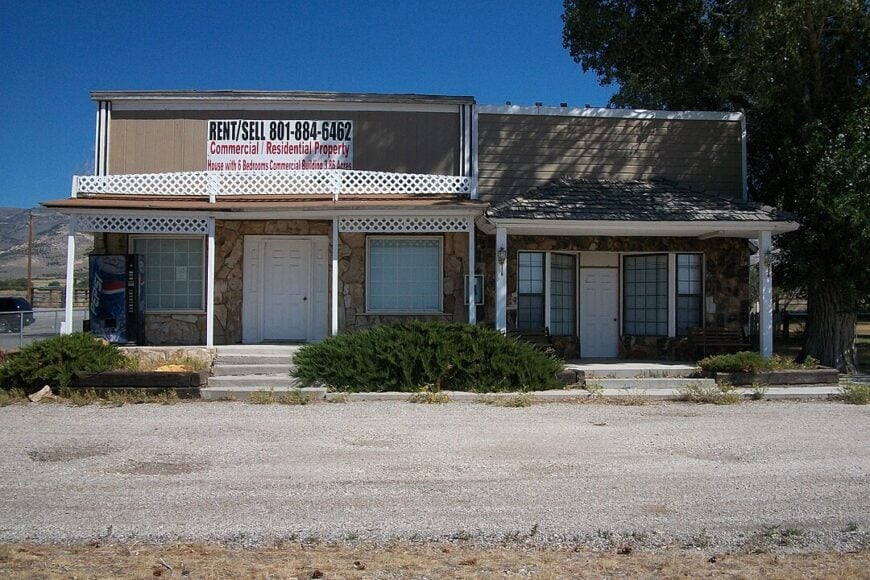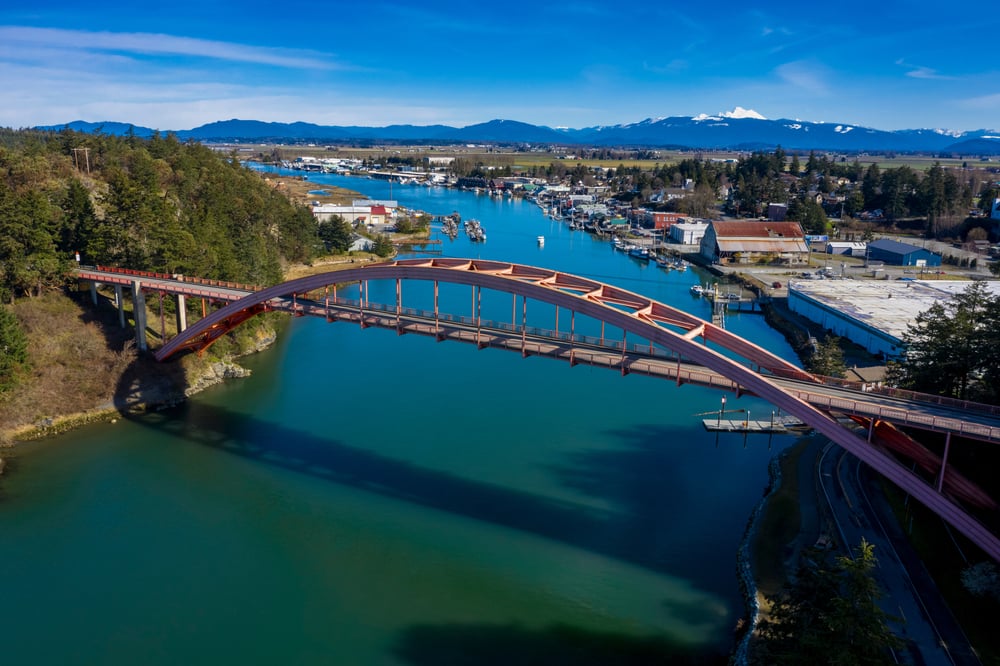Nestled within the vast expanse of the Great Salt Lake Desert are hidden gems waiting to be discovered. These secluded towns offer a glimpse into Utah’s rich history and the rugged beauty of the desert landscape. From quiet ranching communities to haunting ghost towns, each place has its own unique story to tell. Whether you’re an adventurer seeking solitude or a history enthusiast eager to uncover the past, these ten towns provide a retreat from the bustle of modern life. Join us as we count down these remote locales and explore the charm and mystery that lie within the desert’s embrace.
10. Desert Horizons: The Secluded Charm of Park Valley

Park Valley is a tranquil rural community with an approximate population of 200 people. Life here revolves around ranching and farming, with vast open spaces defining the landscape. Visitors can explore the nearby Raft River Mountains, offering hiking opportunities amid stunning desert scenery. The town is also home to historical sites like the old Park Valley schoolhouse, a nod to its rich pioneer heritage. The seclusion of Park Valley is palpable, with endless horizons and a peaceful atmosphere that invites relaxation. Its remote location ensures that the pace of life remains slow and the community tight-knit.
Where is Park Valley?

Located in Box Elder County in northwestern Utah, Park Valley sits near the northern edge of the Great Salt Lake Desert. The town is accessed primarily via state roads that meander through the desert, with the nearest major city, Salt Lake City, over 150 miles away. This distance from urban centers contributes to its secluded nature. Travelers seeking to reach Park Valley should prepare for a journey through expansive desert vistas, which accentuates the town’s isolation and serene environment.
9. Silence of the Flats: The Isolated Community of Knolls

Knolls is a tiny, unincorporated area known for its proximity to the vast Bonneville Salt Flats. With a minimal population, it serves mainly as a gateway for travelers and adventurers. The surrounding landscape is characterized by stark, otherworldly salt flats and dunes, attracting photographers and speed enthusiasts alike. The Knolls Recreation Area offers opportunities for off-highway vehicle (OHV) activities, drawing those eager to traverse the sandy terrain. The seclusion here is profound, with the silence of the flats creating a sense of solitude that’s hard to find elsewhere.
Where is Knolls?

Situated along Interstate 80, about 80 miles west of Salt Lake City, Knolls is enveloped by the expansive Bonneville Salt Flats and desert landscapes. Its isolated location is emphasized by the miles of uninhabited land that separate it from neighboring towns. Accessible primarily by car, travelers will find few signs of civilization as they approach. The vastness of the surrounding flats and dunes contributes to Knolls’ reputation as a place of quiet contemplation and raw natural beauty.
8. On the Fringe: The Quiet Settlement of Oasis

Oasis is a small community that lives up to its name, offering a peaceful respite on the edge of the desert. With a population of just a few hundred residents, it’s a place where everyone knows each other. Agriculture is the mainstay here, with local farms cultivating crops that add a touch of green to the arid surroundings. Visitors might enjoy bird-watching near the Sevier River or simply taking in the expansive skies that are perfect for stargazing. Oasis’s secluded nature is underscored by its vast open landscapes and the tranquility that permeates the area.
Where is Oasis?

Located in Millard County, central Utah, Oasis lies near the intersection of U.S. Route 6 and State Route 257. The town is surrounded by desert plains, with the nearest larger town, Delta, approximately 10 miles away. Despite its relative accessibility, Oasis retains a sense of seclusion due to the sparse population and the surrounding undeveloped land. The journey to Oasis takes travelers through wide-open spaces, reinforcing the feeling of being on the fringe of civilization.
7. Solitude in the Sands: The Remote Area of Lakeside

Lakeside is an unincorporated community that offers solitude near the western shores of the Great Salt Lake. With a small population primarily involved in railroad operations and mining, it’s a quiet place where the desert meets the lake. The surrounding area is a haven for wildlife, particularly migratory birds, making it a hidden gem for bird enthusiasts. The town’s seclusion is enhanced by the rugged beauty of the shoreline and the vast stretches of desert sand that envelop it. Lakeside provides a stark contrast between the serene waters and the arid land, creating a unique and peaceful environment.
Where is Lakeside?

Lakeside is situated in Box Elder County, along the western edge of the Great Salt Lake. Accessed via remote roads off of State Route 30, reaching Lakeside involves traversing miles of desert terrain. The town’s isolation is pronounced, with the nearest significant community being over 50 miles away. This remoteness makes Lakeside a retreat for those seeking to disconnect from the outside world and immerse themselves in the natural beauty of Utah’s desert and lake landscapes.
6. Desert Outpost: Uncovering Gold Hill’s Mining Past

Gold Hill is a secluded former mining town with a rich history dating back to the late 19th century. Once bustling with activity during its gold and arsenic mining boom, it now holds the quiet remnants of that era. Visitors can explore old mine shafts and abandoned buildings that whisper tales of prosperity and hardship. The rugged terrain provides opportunities for hiking and off-road exploration. Gold Hill’s seclusion is evident in its abandoned streets and the sense of stepping back in time, offering a hauntingly beautiful glimpse into the past.
Where is Gold Hill?

Located in Tooele County near the Utah-Nevada border, Gold Hill is accessed via remote county roads that wind through the desert. The town is approximately 56 miles south of Wendover, the nearest city of note. Its isolation is a result of both its distance from major highways and the surrounding rough terrain of the Deep Creek Mountains. Visitors venturing to Gold Hill should be prepared for a journey through desolate landscapes, which adds to the town’s mystique and sense of solitude.
5. Forgotten Tracks: The Ruins of Terrace

Terrace is a ghost town that once thrived as a railroad community during the construction of the First Transcontinental Railroad. In its heyday, it was a vital maintenance station with a bustling population. Today, all that remains are the crumbling foundations and overgrown railroad ties, offering a haunting atmosphere. The town’s seclusion and abandonment make it a fascinating destination for history buffs and those intrigued by the remnants of the past. Terrace’s desolate surroundings amplify the feeling of isolation, providing a poignant reminder of the impermanence of such settlements.
Where is Terrace?

Terrace is located in the northwestern part of Utah, in Box Elder County. Reaching it requires traveling on unpaved roads that branch off from State Route 30, with the journey itself highlighting the remoteness of the area. The town sits in the heart of the desert, far from any major towns or services. Its isolated position makes Terrace a quiet, reflective place, accessible mainly to those willing to venture off the beaten path to uncover its historical secrets.
4. Edge of Isolation: The Hidden Hamlet of Grouse Creek

Grouse Creek is a small ranching community with a population of around 80 residents. Tucked away in the northwest corner of Utah, it’s a place where the pioneer spirit endures. The town is surrounded by rugged wilderness, offering opportunities for horseback riding, hunting, and experiencing the raw beauty of the desert landscape. The main industries are cattle ranching and farming, with generations of families maintaining their homesteads. Grouse Creek’s seclusion is a defining characteristic, fostering a close-knit community that thrives on self-reliance and a connection to the land.
Where is Grouse Creek?

Situated in Box Elder County, Grouse Creek is nearly 50 miles from the nearest paved road. Access is via gravel and dirt roads that weave through the desert and mountains. The town lies close to the Idaho and Nevada borders, emphasizing its remote location. This isolation is both a challenge and a cherished aspect of life for residents. For visitors, the journey to Grouse Creek is a venture into the quiet heart of the desert, where modern distractions fade away.
3. Desert Seclusion: The Quiet Life of Callao

Callao is a remote settlement with a population of fewer than 50 people. Located at the foot of the Deep Creek Mountains, it’s a haven for those seeking tranquility and natural beauty. The area is rich in history, once serving as a stop along the Pony Express route. Today, visitors can explore historical markers and enjoy outdoor activities like hiking and wildlife viewing. Agriculture and ranching are the primary industries, sustained by the creek waters that nourish the land. Callao’s seclusion is profound, offering an escape from the noise and pace of the outside world.
Where is Callao?

Callao is located in Juab County, on the western edge of Utah near the Nevada border. Access is primarily via unpaved roads off of U.S. Route 6, requiring careful planning and a reliable vehicle. The town’s remote position is accentuated by the vast stretches of desert that surround it. Visitors should be prepared for limited services and the necessity of self-sufficiency. The journey to Callao is rewarded with stunning desert vistas and a deep sense of peace.
2. Ghostly Remnants: Exploring the Abandoned Town of Lucin

Lucin is an abandoned town that once served as a railroad water stop in the late 19th and early 20th centuries. After the railroad rerouted, Lucin was left to the desert, and today only faint traces of its past remain. The area is known for the Lucin Sun Tunnels, a large-scale earthwork artwork by artist Nancy Holt, attracting art enthusiasts and photographers. The desolate landscape and the play of light through the tunnels create a unique and contemplative experience. Lucin’s seclusion offers a haunting ambiance, where the silence of the desert is both profound and captivating.
Where is Lucin?

Located in Box Elder County, near the Nevada border, Lucin is accessed via remote dirt roads from State Route 30. The town is nearly 100 miles west of Brigham City, emphasizing its isolation. The surrounding Great Salt Lake Desert provides a stark backdrop of salt flats and rugged terrain. Visitors should ensure they are well-prepared for the journey, as services and facilities are nonexistent. The remoteness of Lucin enhances the ethereal quality of the Sun Tunnels and the overall experience of solitude.
1. Hidden Oasis: Discovering the Remote Village of Ibapah

Ibapah is a small, unincorporated community with a population of around 200 people, including members of the Goshute Tribe. Nestled near the Deep Creek Mountains, it’s a place rich in Native American heritage and natural beauty. The area offers opportunities for hiking, exploring petroglyphs, and experiencing the untouched wilderness. Ranching is a primary industry, along with tribal enterprises that sustain the local economy. Ibapah’s seclusion is marked by its distance from urban centers and the preservation of traditional ways of life, making it a unique and culturally significant destination.
Where is Ibapah?

Located in Tooele County, in the far western reaches of Utah, Ibapah is near the Nevada border. Access to the village is via long stretches of remote roads, with the nearest major highway being over 50 miles away. The isolation is profound, with the Deep Creek Mountains providing a majestic backdrop. Travelers heading to Ibapah should be prepared for a journey through vast desert landscapes, embracing the solitude and the opportunity to connect with the land and its history.






